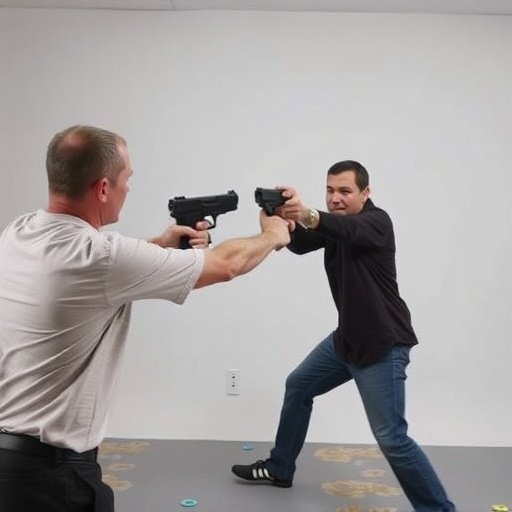Defensive pepper spray, utilizing capsaicin from chili peppers, creates a burning sensation and temporary blindness in attackers up to 20 feet away, offering users safe distance and time to escape or seek help. Proper training ensures maximum effectiveness, balancing impact with legality, which varies widely across jurisdictions. Selecting the right spray involves understanding its defensive pepper spray distance range, quick deployment, and minimal residual effects while adhering to local regulations.
“Personal security is a growing concern, driving innovation in non-lethal deterrent devices. This comprehensive guide explores advanced personal safety tools, with a focus on defensive pepper spray. We delve into the technology behind these devices, analyzing their key components and effectiveness. Understanding optimal defensive pepper spray distance range is crucial for users’ safety.
Additionally, we navigate legal considerations surrounding personal security devices and offer expert advice on choosing the right non-lethal self-defense tool for various scenarios.”
- Understanding Non-Lethal Deterrent Technology
- Defensive Pepper Spray: Key Components and Effectiveness
- Determining Optimal Defensive Spray Distance Range
- Legal Considerations for Personal Security Devices
- Choosing the Right Non-Lethal Self-Defense Tool
Understanding Non-Lethal Deterrent Technology
Non-lethal deterrent technology has evolved significantly, offering a range of personal security devices designed to incapacitate or deter attackers without causing permanent harm. One such tool that has gained popularity is defensive pepper spray, which utilizes capsaicin, the active ingredient in chili peppers, to create a burning sensation and temporary blindness in the eyes of an assailant. The effective distance range of defensive pepper spray plays a crucial role in its usability, with modern models offering a spray reach of up to 20 feet (or more), allowing users to maintain a safe distance from potential threats.
This technology empowers individuals to protect themselves in various situations, from physical assaults to sexual harassment or hostile encounters. The strategic use of non-lethal force can disrupt an attacker’s balance and perception, providing the user with precious time to escape or seek help. With proper training, individuals can learn how to maximize the effectiveness of these devices, ensuring their safety and well-being in potential high-risk situations.
Defensive Pepper Spray: Key Components and Effectiveness
Defensive pepper spray is a popular personal security device designed to incapacitate an attacker at a safe distance, allowing the user to escape or seek help. Key components include a high-concentration capsaicin solution, a precise nozzle for directed spraying, and a durable, easy-to-activate mechanism. The effective defensive pepper spray distance range typically varies from 2 to 10 feet (0.6 to 3 meters), depending on the product and environmental conditions.
This non-lethal deterrent is widely recognized for its effectiveness in disorienting and temporarily disabling assailants, providing crucial time for escape or emergency response. However, factors like wind, weather, and the attacker’s face protection can impact the spray’s reach and potency. Users should therefore choose products suited to their specific needs and be familiar with local laws regarding pepper spray usage.
Determining Optimal Defensive Spray Distance Range
Determining the optimal defensive pepper spray distance range involves balancing effectiveness with safety and legality. Studies suggest that a typical defensive pepper spray can be effective up to 2-3 meters (6-10 feet) in open areas, but this range can vary significantly based on factors like wind, ambient temperature, and the user’s technique. For close-quarters encounters, aiming for the face or eyes at point-blank range (around 30 cm or 1 foot) is crucial to ensure maximum impact.
Legal restrictions also play a significant role in determining the appropriate spray distance. Different jurisdictions have varying laws regarding defensive spray use and permitted distances. Users must familiarize themselves with local regulations to avoid legal repercussions. Additionally, training in proper usage techniques ensures that individuals can deploy the spray effectively while minimizing the risk of collateral damage or excessive force.
Legal Considerations for Personal Security Devices
Personal security devices, such as defensive pepper spray, come with a range of legal considerations that users must be aware of. The legality and regulations surrounding these tools vary significantly from one jurisdiction to another. For instance, while some regions allow citizens to carry pepper spray for self-defense within specified distance ranges, like 30 feet (defensive pepper spray distance range), others have stringent restrictions or outright bans on civilian ownership.
It’s crucial for individuals considering the purchase of a personal security device to research and understand local laws. Failure to comply with these regulations can result in fines, confiscation of the device, or even arrest. Users should also be mindful of the defensive pepper spray distance range permitted under their region’s laws, ensuring they employ the device responsibly and within the legal boundaries to maintain self-protection without causing harm to others.
Choosing the Right Non-Lethal Self-Defense Tool
When selecting a non-lethal self-defense tool, one of the most crucial considerations is the defensive pepper spray distance range. This parameter determines how effectively the device can deter an attacker from close quarters to a safe distance. Look for sprays designed for optimal reach, ensuring they can be deployed quickly and accurately when needed.
Additionally, assess factors like strain on the eyes and respiratory system, as well as the spray’s residual effect. Higher-quality pepper sprays offer better control without causing prolonged discomfort or incapacitation. Consider the legal implications in your region and choose a product that adheres to local regulations regarding non-lethal self-defense devices, especially when it comes to defensive pepper spray distance range and concentration.
In conclusion, non-lethal deterrent personal security devices, such as defensive pepper spray, offer individuals a powerful yet safe option for self-defense. By understanding key components like spray distance range and legal considerations, users can make informed choices to enhance their personal safety. When selecting a tool, consider your specific needs and environment, ensuring it provides the desired defensive pepper spray distance range for effective protection without causing long-term harm.
